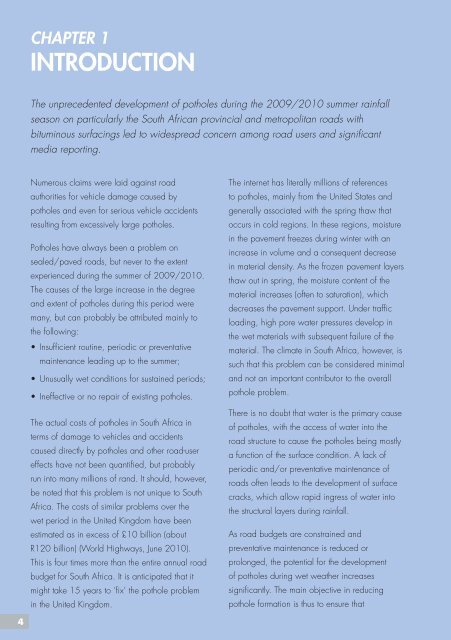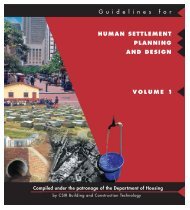POTHOLES: - CSIR
POTHOLES: - CSIR
POTHOLES: - CSIR
- No tags were found...
You also want an ePaper? Increase the reach of your titles
YUMPU automatically turns print PDFs into web optimized ePapers that Google loves.
CHAPTER 1INTRODUCTIONThe unprecedented development of potholes during the 2009/2010 summer rainfallseason on particularly the South African provincial and metropolitan roads withbituminous surfacings led to widespread concern among road users and significantmedia reporting.Numerous claims were laid against roadauthorities for vehicle damage caused bypotholes and even for serious vehicle accidentsresulting from excessively large potholes.Potholes have always been a problem onsealed/paved roads, but never to the extentexperienced during the summer of 2009/2010.The causes of the large increase in the degreeand extent of potholes during this period weremany, but can probably be attributed mainly tothe following:• Insufficient routine, periodic or preventativemaintenance leading up to the summer;• Unusually wet conditions for sustained periods;• Ineffective or no repair of existing potholes.The actual costs of potholes in South Africa interms of damage to vehicles and accidentscaused directly by potholes and other road-usereffects have not been quantified, but probablyrun into many millions of rand. It should, however,be noted that this problem is not unique to SouthAfrica. The costs of similar problems over thewet period in the United Kingdom have beenestimated as in excess of £10 billion (aboutR120 billion) (World Highways, June 2010).This is four times more than the entire annual roadbudget for South Africa. It is anticipated that itmight take 15 years to ‘fix’ the pothole problemin the United Kingdom.The internet has literally millions of referencesto potholes, mainly from the United States andgenerally associated with the spring thaw thatoccurs in cold regions. In these regions, moisturein the pavement freezes during winter with anincrease in volume and a consequent decreasein material density. As the frozen pavement layersthaw out in spring, the moisture content of thematerial increases (often to saturation), whichdecreases the pavement support. Under trafficloading, high pore water pressures develop inthe wet materials with subsequent failure of thematerial. The climate in South Africa, however, issuch that this problem can be considered minimaland not an important contributor to the overallpothole problem.There is no doubt that water is the primary causeof potholes, with the access of water into theroad structure to cause the potholes being mostlya function of the surface condition. A lack ofperiodic and/or preventative maintenance ofroads often leads to the development of surfacecracks, which allow rapid ingress of water intothe structural layers during rainfall.As road budgets are constrained andpreventative maintenance is reduced orprolonged, the potential for the developmentof potholes during wet weather increasessignificantly. The main objective in reducingpothole formation is thus to ensure that4

















